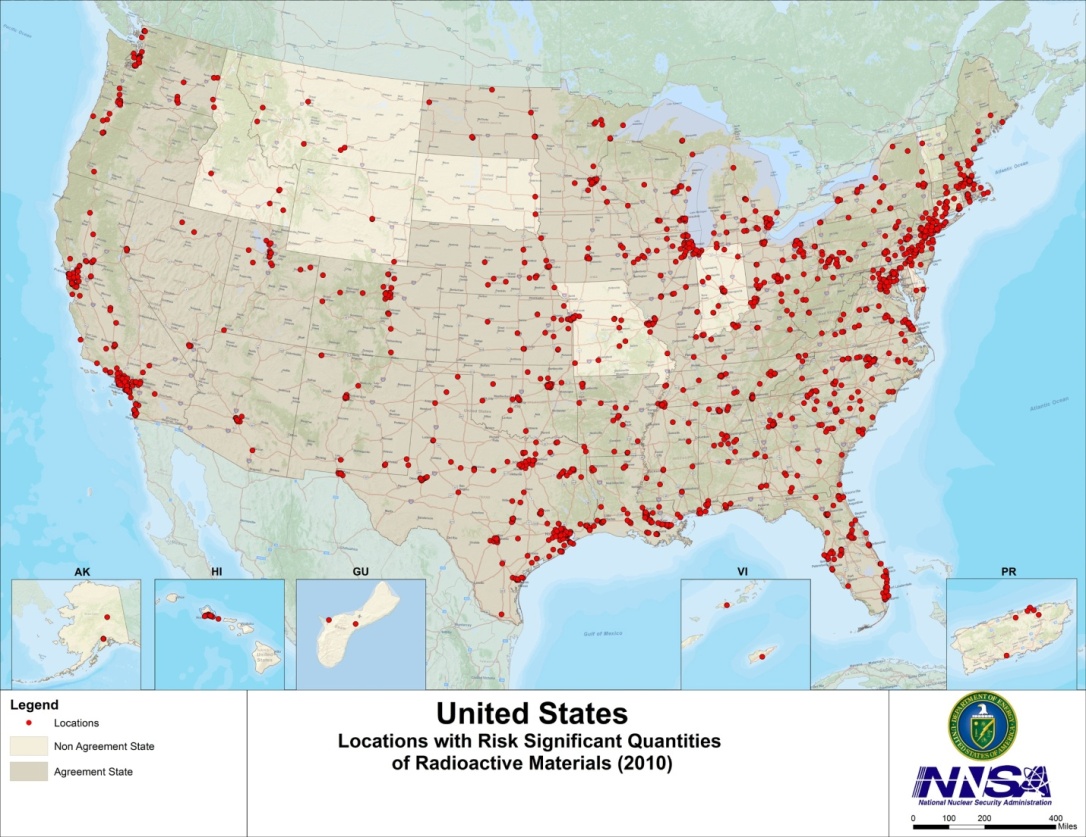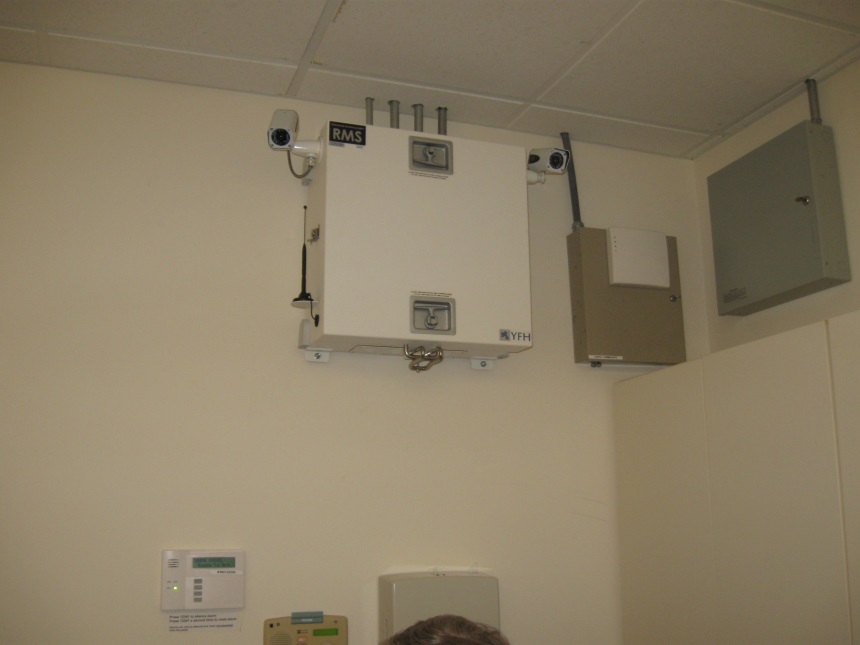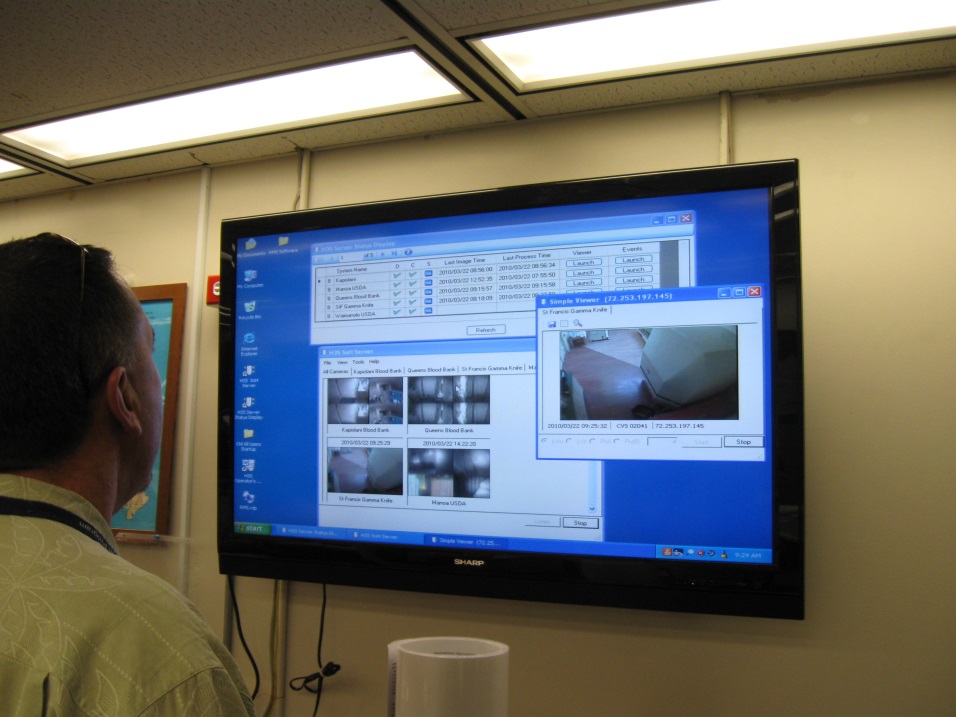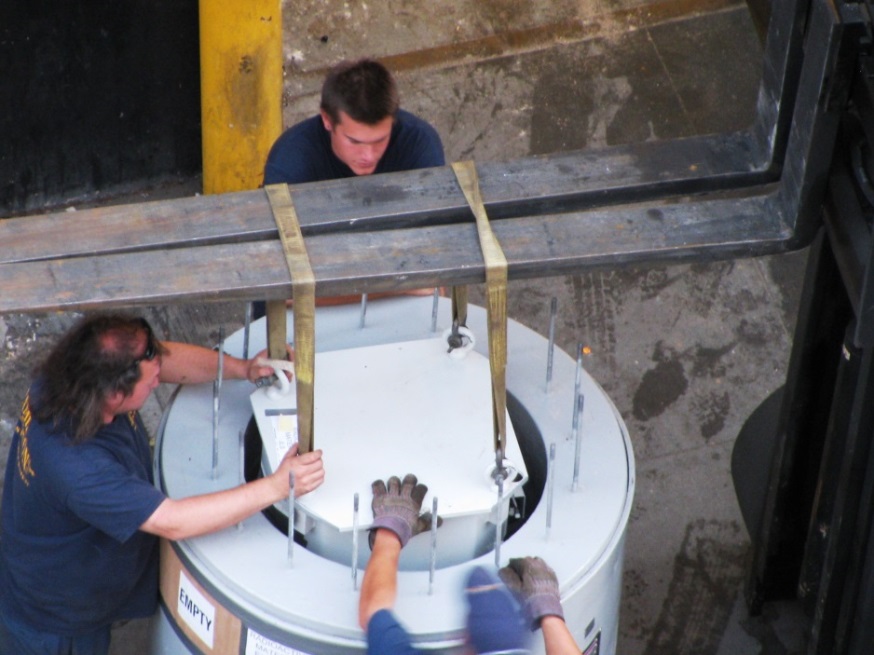Global Threat Reduction Initiative Efforts to Prevent Radiological Terrorism
Saturday, August 17, 2013 at 2:35 am
Suburban location—Anywhere, United States
Three men enter a darkened building of a mid-size university closed for summer break. The university has unarmed security guards that make periodic checks of the campus building exteriors, and the local law enforcement agency is a county police department that interacts with the university on an “occasional” basis. The men enter a third floor laboratory housing a Cesium 137 irradiator. The irradiator is used by faculty and students to expose tissue samples to high levels of radiation during their research. Using simple tools, they partially dismantle the device and remove the radioactive source capsule containing 3,000 curies of Cesium 137. The three perpetrators move the material in a crudely constructed lead bucket providing light shielding and minimal protection to them, and place the material in a self-storage locker ten miles away. The theft goes unnoticed until Monday morning when it is reported to the county police. The county police are not immediately concerned or recognize the significance of the theft or the amount of radioactive material taken.
Monday, August 19, 2013 at 10:45 am
Urban location—Anywhere, United States
Over the past two days, the three perpetrators have taken the radioactive material and assembled it with explosives stolen from a construction site into a Radiological Dispersal Device (RDD), commonly called a “dirty bomb.” The device has been transported to a medium-sized city, one hundred miles from the university. All three men are suffering from radiation sickness but are able to detonate the device in the city’s business and financial district. Seven people, in addition to the three terrorists, are killed in the explosion. The resulting contamination from the dispersal of the Cesium 137 produces general panic due to health concerns, along with potentially devastating financial consequences.
The above scenario is fictional but will serve as an introduction to the discussion of what could have been done to deter or interdict the attack. Could the university and local police have had strategies to better secure the radioactive materials that were stolen? Could the local police have been notified in a timelier manner through a closer working relationship with university radiation safety professionals? Could police have searched for the material after it had been stolen, while in transit, during assembly at self-storage facility, or while en route to the final target?
The attacks of September 11, 2001, heightened the nation’s concerns regarding all forms of terrorism in the U.S., including the potential use of radioactive materials in a terrorist act. The possibility of such an attack has been of particular concern because of the widespread use and availability of radioactive materials in the United States industry, hospitals, and academic institutions. Loss or theft of such materials, in risk-significant quantities, could lead to their diversion for malicious use in a Radiological Dispersal Device. This past April’s bombing at the Boston Marathon again raised such concerns. In the wake of the Boston attack, Richard Daddario, Deputy Commissioner for counterterrorism at the New York City Police Department, testified that the psychological and economic fallout from a radiological “dirty bomb” event could demand a much longer recovery than a conventional strike. 1
An RDD is a device or mechanism that is intended to spread radioactive material from the detonation of conventional explosives or other means. An RDD detonation would likely result in few deaths (mainly from the explosion), but substantial social and economic impacts could result from public panic, decontamination costs, and denial of access to area for extended periods of time.
The economic consequences of an RDD attack could be enormous. As a point of reference, according to an estimate by Bloomberg Businessweek, it cost $333 million to shut down Boston for a day to facilitate the manhunt for Dzokhar Tsarnaev. Imagine the costs of closing a large portion of any major city for substantially longer periods. An attack at a port could also have major economic consequences. A 2007 study published in Risk Analysis estimated that the economic consequences from a shutdown of the harbors due to the contamination from a plausible dirty bomb scenario could result in losses in the tens of billions of dollars, including the decontamination costs and the indirect economic impacts due to the port shutdown.2
Global Threat Reduction Initiative
In order to prevent a radiological attack, the United States government sponsors a broad range of programs designed to prevent, detect and respond to the loss or theft of nuclear and radiological material. The Global Threat Reduction Initiative (GTRI) is a Department of Energy (DOE) program designed to reduce the amount of vulnerable nuclear and radiological material located at civilian sites worldwide and improve protection of these materials. Because the bulk of its work is pursued overseas, the program is best known for its international activities, in particular removing vulnerable nuclear material from, for example Kazakhstan, and securing high risk radioactive materials, for example in Russia. However, a lesser known and equally complex element of GTRI is its domestic component carried out in the United States. The domestic component involves the interaction and cooperation between federal government officials, scientists and policy makers with state and local police, emergency officials, and operators of private and public institutions, such as hospitals.
This article is intended to describe the domestic component of the GTRI; how it is implemented, why it is needed and how state and local officials take advantage of the program. The goal of this article is to present the joint views of a local police official together with those of a scientist and former policy maker and to explore the technical and policy issues associated with domestic threat reduction programs.
The Context
Radiological materials are located throughout the United States (see Figure 1) with the majority of high activity sources located in large urban population centers. A successfully deployed RDD using radioactive sources commonly found in public facilities such as hospitals could potentially result in radioactive contamination that could require relocation of inhabitants, prohibit the use of facilities, and have debilitating economic impacts. 3
Most radioactive sources in the U.S. are regulated by the Nuclear Regulatory Commission and state authorities. GTRI works with civilian sites to enhance security for their radiological materials; however, it does not regulate them. Participation with GTRI is voluntary on the part of sites although GTRI has an aggressive outreach program to encourage sites to participate. In addition, the Department of Homeland Security’s Domestic Nuclear Detection Office provides assistance to state and local officials in establishing an overall architecture for detecting nuclear and radioactive material that are not under regulatory control, e.g. which have already been lost or stolen. This detection assistance supports the GTRI’s efforts by providing equipment and training to establish a general baseline for state and local first responder nuclear and radiological detection capabilities, but is not focused on specific sites.
Some have expressed concern that funding for radiological threat reduction is better spent overseas, in particular in countries that do not have a strong regulatory infrastructure, as the U.S. does. Indeed, GTRI’s overseas accomplishments are much more frequently in the news. In the U.S., the protection of sources is primarily the responsibility of the owner/operator, following the requirements of the regulator. So, why should the federal government spend funds to protect radiological sources when they should already be adequately protected? Through the current and evolving program, GTRI and partner agencies and institutions have created a strong partnership for a well-rounded domestic security program. The domestic portion of GTRI has evolved to one that seeks to fill the gaps that may exist in the very complicated relationship between local, state, and federal agencies in preventing and responding to radiological security incidents. The focus of the program is shifting toward sustainability of completed security upgrades and improved response capabilities and communication networks.

Locations in the U.S. with risk-significant quantities of radiological sources. 4
Domestic Security Enhancement Program
Since GTRI’s domestic security enhancement program began in 2008, it has worked with host sites to enhance security at more than five hundred buildings which host over four million curies of radioactive materials. GTRI physical security enhancements are applied on a voluntary basis to assist sites in the prevention and detection of any unauthorized access to radiological sources located in their facility. The physical protection principle of detection, specifically early detection, means that detection of a theft is early enough in the act that it can be stopped at the site or nearby. Ideally, early detection should allow time for response forces to prevent an adversary from acquiring the radioactive material. GTRI’s detection upgrades build upon sites’ existing security measures but may include enhancing the following physical protection system components:
- Biometric access control devices
- Door alarms
- Motion sensors
- Cameras
- Duress buttons
- Radiation sensors
- Electronic tamper indicating seals
- Remote monitoring systems
The Insider Threat
A remote monitoring system (RMS) is a critical security measure for detecting an insider threat because the insider (by definition) will have access to the device containing the radioactive material, or to the material itself depending on the type of facility. The insider will also have authorization to use some or all of the site’s access control and detection devices without sending an alarm of unauthorized access. In addition to detecting an insider, the RMS also improves the response by a site’s local law enforcement or other responding agencies by providing them with critical assessment information immediately.

For most U.S. sites, timely notification to local law enforcement is critical to prevent potential theft attempts. The RMS integrates what GTRI calls critical alarms (e.g., device tampering to gain access to the radioactive source(s), increased radiation levels indicating that the source has been removed from its shielding, communications loss between the site and monitoring station, or loss of power) with real time live video images. For increased protection, the RMS is housed in a tamper-indicating housing with battery back-up to ensure its continued operation. To address information security concerns, the RMS also encrypts the video and alarm data. The RMS can send alarm and video data simultaneously to onsite and offsite security and local law enforcement monitoring stations to prevent single-point failures in a site’s security and response planning.

Enhancing Delay Measures
Along with early detection capabilities, GTRI also provides sites with delay enhancements that impede an adversary’s progress to access nuclear and radiological materials. By increasing the delay time and adding valuable minutes in an adversary’s attack time lines, responders have more time to interrupt the adversary before they can remove and steal these materials. GTRI’s delay systems may include:
- Device tie downs
- Security cages
- Security grating
- Hardened doors/rooms
- Ballistic glass
- In-Device Delay Kits
A particularly important delay enhancement is the In-Device Delay kit for irradiators. The National Research Council, a private nonprofit institute, performed a risk and consequence analysis, which showed Cesium Chloride irradiators pose relatively higher security risks compared to other radiological materials.5 To help mitigate this risk, GTRI and DHS developed In-Device Delay (IDD) kits for Cesium irradiators that can be installed on the device. The installation of the IDD kits on selected irradiators significantly increases the time and/or difficulty involved if an intruder tries to remove a source—while not impacting the functionality of the irradiator—and consequently is an important element of security enhancements.
Response Capabilities
One of the most important elements of any security system is a timely, well-equipped, well-trained response team of appropriate size to interrupt and neutralize the adversary before they gain access to the radioactive source or immediately after they gain access. First responders from state and local law enforcement do not work with nuclear material or radiological sources on a daily basis and may lack knowledge of the risks posed by these materials. GTRI has therefore made a focused effort to provide security personnel and local law enforcement with the tools and training to help prepare them to respond to an event involving nuclear or radiological material.
In 2008 GTRI began to sponsor table top exercises for GTRI partners at select nuclear and radiological sites in the United States. These exercises are conducted at predominately private institutions, hospitals and universities and bring together key decision-makers from the actual agencies that would respond to a terrorist WMD incident. At the exercise, host level players include on-site security forces, radiation safety personnel, facility managers and public affairs personnel. At the city and state levels, players can include police, fire, hazmat, EMS, Office of Emergency Management, regulatory agencies and National Guard Civil Support Teams. At the federal level players can include the FBI, DOE/NNSA nuclear response assets the Federal Emergency Management Agency, the Nuclear Regulatory Commission, the Department of Homeland Security and the Environmental Protection Agency.
The overall exercise objectives are to promote cross-sector communication, cooperation, and team-building among public and private sector first responders and to exercise FBI lead responsibility for criminal investigation. In addition, the exercise allows players to examine newly developed tactics, techniques, and procedures resulting from GTRI voluntary security enhancements. The exercises promote attack prevention through intelligence sharing and a coordinated approach to neutralize the threat, along with site specific integrated response planning with federal, state, local, and private sector partners.
Since the first GTRI exercise in December 2008, there have been 29 Silent Thunder table top exercises at state and private universities, hospitals, research and test reactors, the U.S. Department of Agriculture and National Institutes of Health. To date, 329 FBI agents and 3760 players and observers have participated in these GTRI table-top exercises.
Additionally, at the Y-12 National Security Complex in Oak Ridge, Tennessee, GTRI offers participants a three-day alarm response training course. This training includes hands-on exercises and classroom training and teaches site personnel and local law enforcement how to protect themselves and their communities when responding to alarms indicating possible theft of radiological materials.
Removing Disused Sources Before They Can Become a Threat
The final element of GTRI’s domestic radiological security effort involves the removal of sources that are unused and may ultimately be lost or stolen due to lack of attention. In addition to security enhancements, GTRI’s Off-Site Source Recovery Program (OSRP) removes thousands of excess or disused sources in the United States annually. The initial scope of the project included a narrow group of sources (those that fell into the regulatory category of Greater than Class C (GTCC) low-level radioactive waste), but since the terrorist attacks of September 11, 2001, OSRP’s scope has expanded to include the recovery of other sources. 6 Over the years, OSRP has recovered more than 30,000 sources from more than 1,000 sites located in all 50 U.S. states, Washington D.C., and Puerto Rico.7 By removing sources from facilities that no longer had a use for them, GTRI has removed the risk of these materials to be potentially used in a RDD, thus resulting in permanent threat reduction.

From “Global” Threat Reduction to “Local” Threat Reduction
At its core, the GTRI domestic program is a partnership between federal officials, state and local officials and facility operators. One example of this is in Philadelphia, where over a dozen sites are protected in the Philadelphia Metropolitan Area by the GTRI Program, ranging from hospitals and universities, drug manufacturers and government research labs, to one of the American Red Cross’s largest blood distribution centers. Law enforcement agencies (the Philadelphia Police Department being the largest), have benefited tremendously from GTRI’s tabletop exercises, training at the Y12 National Security Complex, and personal radiation detectors provided by the GTRI Program.
The Philadelphia region had an existing Preventive Radiological Nuclear Detection (PRND) program supported by the Domestic Nuclear Detection Office (DNDO) of DHS that the NNSA was able to use as a vehicle to integrate their source security into the overall effort to prevent radiological and nuclear terrorism. This created a very effective two tiered “inside-out” and “outside-in” prevention strategy. The existing deployment of nuclear detection assets protected special events and provided a 24/7 “steady state” coverage from threats from outside the region. The regional law enforcement agencies, assisted by DNDO, were able to field a range of detection equipment on a daily basis, including aircraft, mobile and marine systems. The addition of the GTRI program allowed for the protection of radiological sources of concern within and near relevant facilities while bolstering the defense against an “insider threat” due to the closer relationships created by participation. This “inside-out” approach took Philadelphia’s protection and response effort to the next level by adding source security as a priority. The previous outwardly focus PRND program was equipment and personnel driven while the GTRI Program stresses relationship building between the partner sites and their local law enforcement agencies.
The scenario depicted at the beginning of this article would have multiple chances at prevention/interdiction in the Philadelphia model. The GTRI alarm systems and response programs would have protected the material and facilitated an immediate response and the existing detection assets could be deployed to recover any stolen material. Together, the two programs form an effective deterrent.
The University of Pennsylvania has been the largest beneficiary of the GTRI Program in the area, and has served as a model site for others in the nation for implementing the security and emergency response upgrades. All partners, facility and law enforcement, have enjoyed a much closer relationship that extends to joint training and exercises as well as facility operators providing subject matter expert support to the overall PRND effort.
Due in part to the GTRI program, in October 2013, all the protected facilities alarm notifications are received in the regional “Fusion Center”, the Delaware Valley Intelligence Center (DVIC), creating another layer of defense and allowing for a regional protection and response capability.
Conclusion
As mentioned at the outset of this paper, some in the policy community believe U.S. radiological protection dollars are better spent overseas, where regulatory controls are not as effective as those in the United States. It is true that despite years of effort, many other countries do not have strong regulatory infrastructures for managing access to radiological and nuclear material and funding overseas is well spent. However, as illustrated above, this view does not fully take into account the multifaceted needs of radiological security, which requires the integration of the facility operators, state, local and federal capabilities. Moreover, while sources overseas are generally less well regulated and protected than U.S. sources, radiological sources in the U.S. should receive special attention because they pose the greatest risk: diversion closest to a target of the attack minimizes the likelihood of detection through the global detection capabilities overseas and at U.S. borders. In this view, it makes little sense for the federal government to help provide for a security measure overseas, but not domestically, where the risk may be higher.
A recent Government Accountability Office (GAO) report is instructive in regard to the limitations of regulatory controls. GAO was asked by Congress to determine the extent to which NRC’s regulations ensure the security of radiological sources at U.S. medical facilities and the status of NNSA’s efforts to improve the security of sources at these facilities. GAO reviewed relevant laws, regulations, and guidance; interviewed federal agency and state officials; and visited 26 hospitals and medical facilities in Washington, D.C. and 7 states. The review concluded that existing regulatory requirements do not consistently ensure the security of high-risk radiological sources at the 26 selected hospitals and medical facilities visited. According to the review, one reason for this is that the requirements are broadly written and do not prescribe specific measures that hospitals and medical facilities must take to secure medical equipment containing sealed sources, such as the use of cameras or alarms. Rather, the requirements provide a general framework for what constitutes adequate security practices, which is implemented in various ways at different hospitals. Some of the medical equipment in the facilities visited was more vulnerable to potential tampering or theft than that of other facilities because some hospitals developed better security controls than others. 8
Protecting America from a radiological attack requires a strong alliance between facility operators, state, federal and local officials. In the U.S., the NRC sets the regulatory framework that includes security requirements, licensing, inspection, and enforcement. But the regulatory framework is insufficient for all threats; rather it provides a common baseline level of security. GTRI works with sites to build upon these security standards set by NRC and state regulations. GTRI’s voluntary security enhancements provide sites with security best practices which further enhance security above regulatory requirements. Because the GTRI upgrades are voluntary and may have cost implications for the facility operators as well as state and local authorities, it is essential that all partners are aware of the threats and risks involved in working with certain radioactive material as well as programs to mitigate these risks.
Warren Stern is Senior Advisor in Brookhaven National Laboratory’s Nonproliferation and National Security Department. In 2010, he was appointed by President Obama to lead the Domestic Nuclear Detection Office at DHS and before that, Head of the IAEA’s Incident and Emergency Centre. He has also held a number of leadership positions at the U.S .Department of State, Arms Control and Disarmament Agency and CIA.
Lieutenant Edward Baldini is a twenty four year veteran of the Philadelphia Police Department and has been assigned to the Counter Terrorism Operations Unit since its inception in spring 2002. He has assisted in development of Counter Terrorism Training at the local, state and national level. He has been very active with Preventive Radiological/Nuclear Detection (PRND) mission and has assisted the Domestic Nuclear Detection Office (DNDO) and the National Nuclear Security Administration (NNSA) in several initiatives. He holds a Bachelor’s Degree from Philadelphia University and a Master’s Degree from the Naval Postgraduate School in Monterey, California. He is also a graduate of Northwestern University Center for Public Safety’s School of Police Staff and Command.
The FY2026 National Defense Authorization Act (NDAA) paints a picture of a Congress that is working to both protect and accelerate nuclear modernization programs while simultaneously lacking trust in the Pentagon and the Department of Energy to execute them.
While advanced Chinese language proficiency and cultural familiarity remain irreplaceable skills, they are neither necessary nor sufficient for successful open-source analysis on China’s nuclear forces.
Satellite imagery has long served as a tool for observing on-the-ground activity worldwide, and offers especially valuable insights into the operation, development, and physical features related to nuclear technology.
This report outlines a framework relying on “Cooperative Technical Means” for effective arms control verification based on remote sensing, avoiding on-site inspections but maintaining a level of transparency that allows for immediate detection of changes in nuclear posture or a significant build-up above agreed limits.